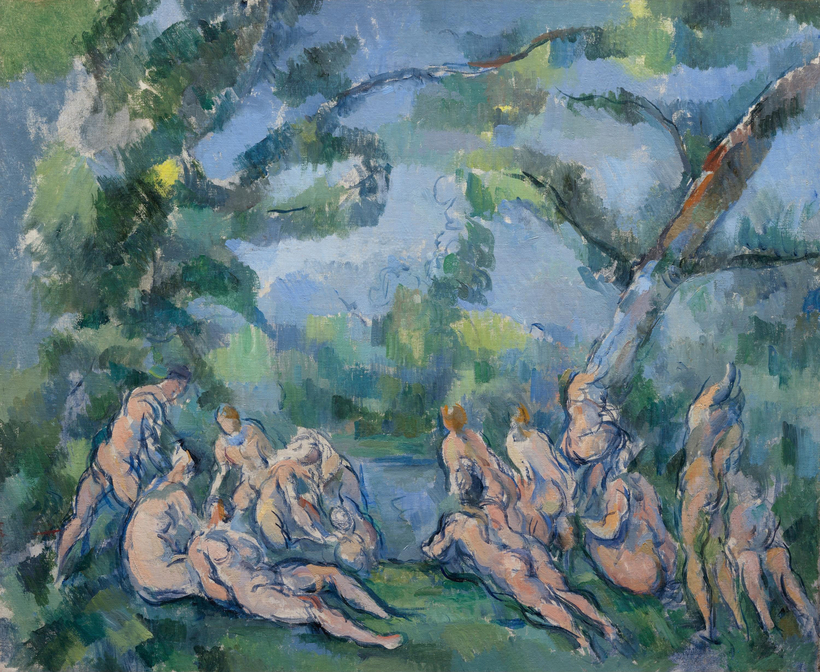“I shall astonish Paris with apples,” Paul Cézanne said defiantly in 1895, at 56, on the eve of his first and long-overdue solo exhibition there. Unlike the dreamy, colorful Impressionists whose work was the talk of the capital, Cézanne’s experimental painting had trouble finding a sweet spot with the public, critics, and collectors. This summer, his apples—and mountains and bathers and portraits of the solid citizens of Aix-en-Provence, his sunny, beloved birthplace—are the locus of a cornucopia of exhibitions and events that should astonish us. Even if we think we know Cézanne well.
The centerpieces are the opening of his restored family home, the Bastide du Jas de Bouffan (it includes a once hidden mural), and a landmark exhibition that re-unites the works he made there, “Cezanne at Jas de Bouffan,” at the Musée Granet—the first day for both is June 28. Other events include an exhibition focusing on Cézanne’s Aixois circle, now on view at the Musée du Vieil Aix; a recapitulation of previous Cézanne exhibitions, opening June 19 at the historic Pavillon de Vendôme; walking tours that visit locations in the city important to his life; and guided rambles on the enhanced woodland trails of the Bibémus quarries, the sandstone plateau where Cézanne’s journey toward abstraction took hold. Also on June 28, the artist’s atelier at Les Lauves reopens. Here, overlooking the city, he painted his last great works.
The importance of Aix—the wellspring for Cézanne’s precise, original practice—cannot be overstated.

Cézanne always knew he wanted to be an artist. His father instead pushed him toward law, and then the family business—banking. But at 22, lured by his school-mate the writer Émile Zola, he took his first breakaway trip to Paris to study art. Though brief, it presaged a restless shuttle between the city where he hoped to make his name, and Aix, his principal refuge. While he had once covered the walls of the Jas with classical murals, in Paris the moody and introspective young man painted torrid scenes of rape and orgies drawn from old masterworks, subjects distinctly at odds with his reclusive personality and intense aversion to using nude models. Urban life and the rejection of his work proved painful.

Withdrawing to Aix, Cézanne began to explore the surface effects of color and light in landscape and portraiture, yet he struggled to fully embrace the gauzy Impressionist aesthetic. With the encouragement of new friends Camille Pissarro, Claude Monet, and Auguste Renoir, and determined to succeed in the city, he returned to Paris and showed with them in the first Impressionist exhibition, in 1874.

Tormented anew by the continuing lack of recognition, he often retreated to the attic atelier at the Jas. There he increasingly portrayed the world around him using palette knives laden with paint; brusque, angular brushstrokes; and uncommon perspectives—what one critic called “painterly swagger.”
Marie-Hortense Fiquet, a model who bore Cézanne a son and whom he eventually married, was long hidden from his judgmental father. Cézanne’s many portraits of her—he likened her shape to that of an apple—are among his most revered. Local peasants and farmhands also endured countless sittings, for instance, as card players. These portraits revealed the human face and body as another kind of landscape. Apples—rich, red, ripe, shining—often anchored Cézanne’s still lifes, and were as sensual as his idealized bathers.

In 1899, the Jas was sold. Cézanne worked in Fontainebleau and in a small studio in Aix as his atelier at Les Lauves was being readied. By 1902 he was installed there, working feverishly in an Indian summer of production, having finally found a receptive audience. His mature work relied on an emotional compass set forever to the cone of the Montagne Saint-Victoire, the cubes of the local farmhouses, and the triangular formation of monumental bathers—unprecedented breakthroughs that verged on abstraction. Cézanne redoubled his production despite worsening diabetes. He died in 1906, after collapsing in a rainstorm.

Pablo Picasso and successive generations of artists revered Cézanne for his technical innovations, the richness he found in the quotidian, and his fierce fidelity to his singular vision. Though his work is displayed in many international museums, his cherished Aix is now the destination for new discoveries and insightful interpretation.
For more information on these exhibitions, visit the Cezanne 2025 Web site
Patricia Zohn has contributed to numerous publications, including Wallpaper, Artnet, the Huffington Post, The New York Times, and the Los Angeles Times


